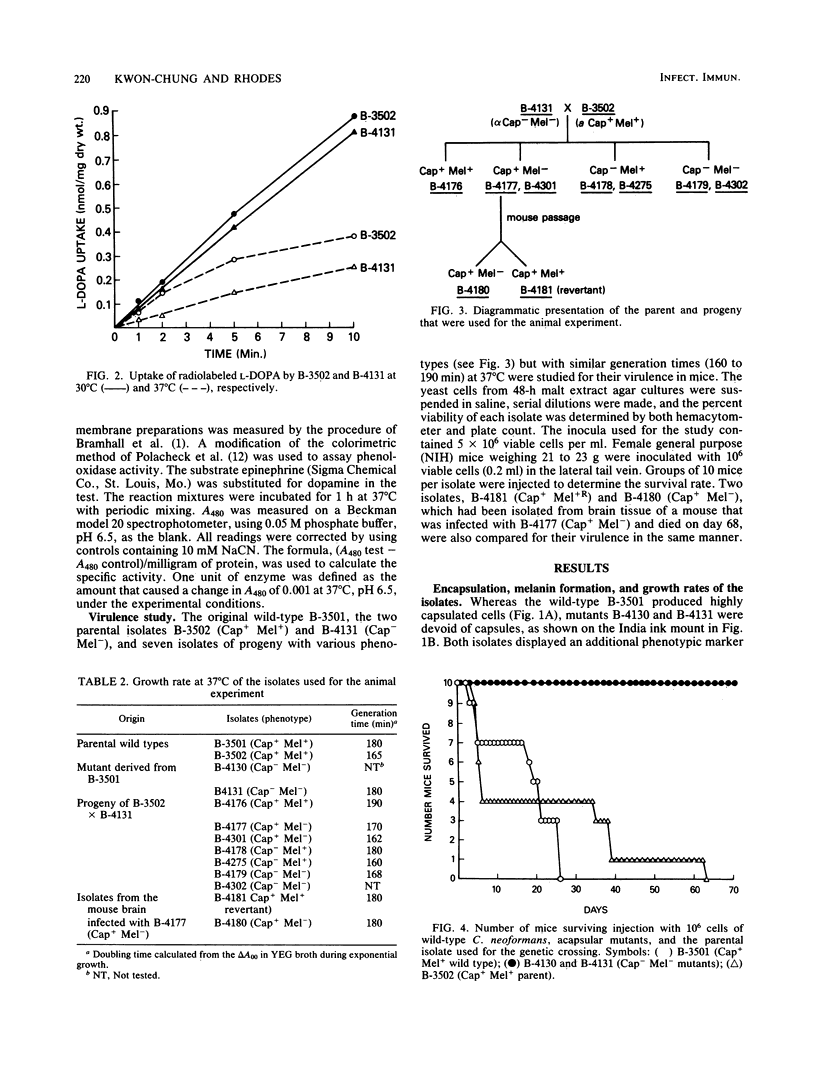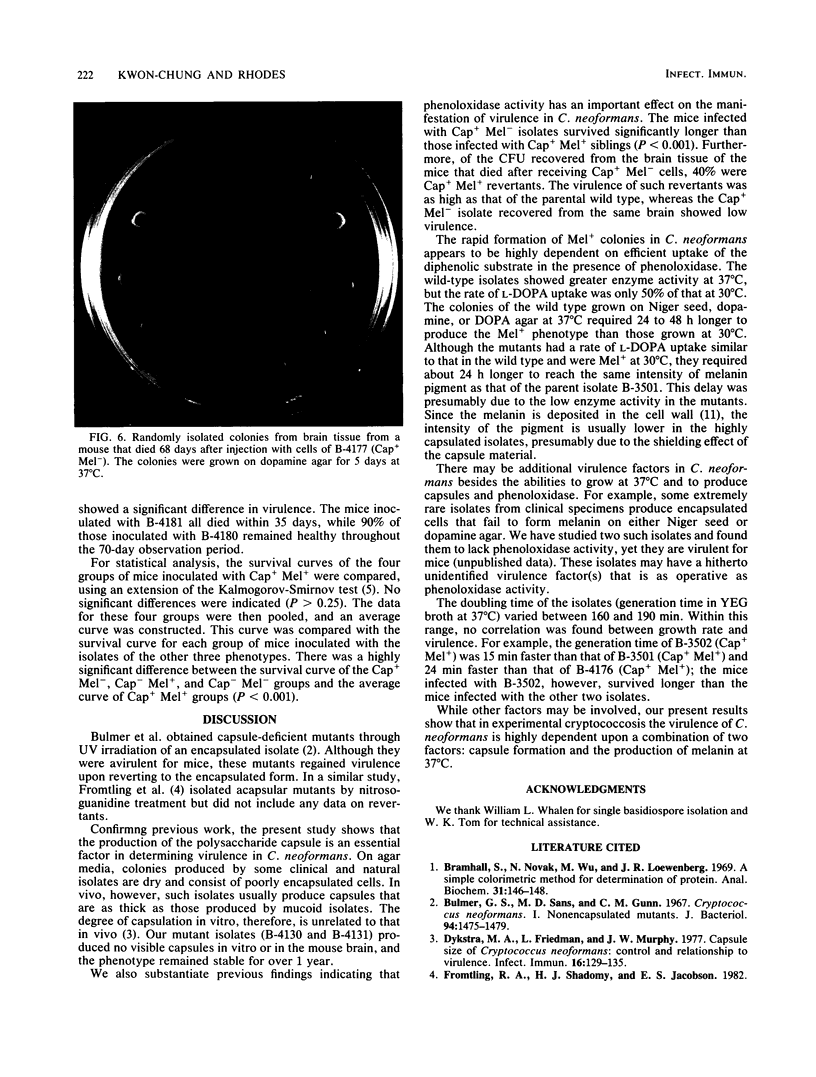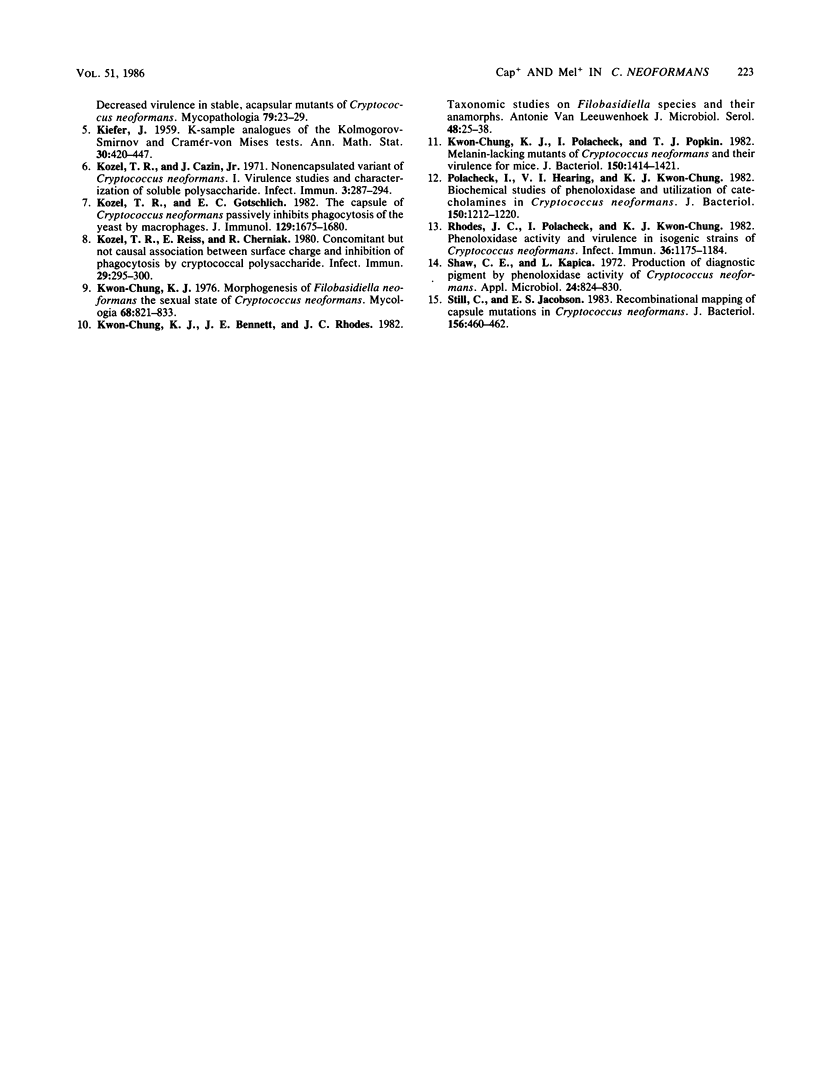Abstract
Acapsular (Cap-) mutants of Cryptococcus neoformans var. neoformans that produce melanin (Mel+) on diphenol media at 30 degrees C but not at 37 degrees C were found to be avirulent for mice. Compared with wild-type isolates, the mutants had a lower rate of L-3,4-dihydroxyphenylalanine uptake at 37 degrees C and showed an insignificant level of phenoloxidase activity at both temperatures. To study the relationship of Cap and Mel phenotypes to virulence in mice, we crossed one of the mutants (Cap- Mel-) with a wild type (Cap+ Mel+) to obtain four classes of progeny (Cap+ Mel+, Cap+ Mel-, Cap- Mel+, and Cap- Mel-). The progeny with the Cap+ Mel+ phenotype and the wild-type parent (Cap+ Mel+) were inoculated into mice (10(6) cells per mouse) and, within 40 days, produced fatal infection in 90 to 100% of the animals. None of the other three phenotypes produced fatal infection within the same period. While progeny with the Cap+ Mel- phenotype did produce fatal infection after 40 days, 70 to 90% of the mice survived at least until day 70. However, in the isolates recovered from the brain tissue of a mouse that died on day 68, nearly 40% of the CFU had reverted to the Cap+ Mel+ type. The virulence of one of these revertant Cap+ Mel+ isolates was compared with that of a Cap+ Mel- isolate recovered from the same tissue. One hundred percent of the mice inoculated with the revertant died within 35 days, while no fatal infection was produced in the mice inoculated with the Cap+ Mel- isolate within the same period. The isolates with the Cap- Mel+ or Cap- Mel- phenotype not only failed to produce fatal infection but failed to revert to the Cap+ Mel+ type in the mouse brain during the experimental period. These results indicate that both the Cap+ phenotype and the Mel+ phenotype are important indicators of virulence in C. neoformans.
Full text
PDF





Images in this article
Selected References
These references are in PubMed. This may not be the complete list of references from this article.
- Bramhall S., Noack N., Wu M., Loewenberg J. R. A simple colorimetric method for determination of protein. Anal Biochem. 1969 Oct 1;31(1):146–148. doi: 10.1016/0003-2697(69)90251-6. [DOI] [PubMed] [Google Scholar]
- Bulmer G. S., Sans M. D., Gunn C. M. Cryptococcus neoformans. I. Nonencapsulated mutants. J Bacteriol. 1967 Nov;94(5):1475–1479. doi: 10.1128/jb.94.5.1475-1479.1967. [DOI] [PMC free article] [PubMed] [Google Scholar]
- Dykstra M. A., Friedman L., Murphy J. W. Capsule size of Cryptococcus neoformans: control and relationship to virulence. Infect Immun. 1977 Apr;16(1):129–135. doi: 10.1128/iai.16.1.129-135.1977. [DOI] [PMC free article] [PubMed] [Google Scholar]
- Fromtling R. A., Shadomy H. J., Jacobson E. S. Decreased virulence in stable, acapsular mutants of cryptococcus neoformans. Mycopathologia. 1982 Jul 23;79(1):23–29. doi: 10.1007/BF00636177. [DOI] [PubMed] [Google Scholar]
- Kozel T. R., Cazin J. Nonencapsulated Variant of Cryptococcus neoformans I. Virulence Studies and Characterization of Soluble Polysaccharide. Infect Immun. 1971 Feb;3(2):287–294. doi: 10.1128/iai.3.2.287-294.1971. [DOI] [PMC free article] [PubMed] [Google Scholar]
- Kozel T. R., Gotschlich E. C. The capsule of cryptococcus neoformans passively inhibits phagocytosis of the yeast by macrophages. J Immunol. 1982 Oct;129(4):1675–1680. [PubMed] [Google Scholar]
- Kozel T. R., Reiss E., Cherniak R. Concomitant but not causal association between surface charge and inhibition of phagocytosis by cryptococcal polysaccharide. Infect Immun. 1980 Aug;29(2):295–300. doi: 10.1128/iai.29.2.295-300.1980. [DOI] [PMC free article] [PubMed] [Google Scholar]
- Kwon-Chung K. J., Bennett J. E., Rhodes J. C. Taxonomic studies on Filobasidiella species and their anamorphs. Antonie Van Leeuwenhoek. 1982;48(1):25–38. doi: 10.1007/BF00399484. [DOI] [PubMed] [Google Scholar]
- Kwon-Chung K. J. Morphogenesis of Filobasidiella neoformans, the sexual state of Cryptococcus neoformans. Mycologia. 1976 Jul-Aug;68(4):821–833. [PubMed] [Google Scholar]
- Kwon-Chung K. J., Polacheck I., Popkin T. J. Melanin-lacking mutants of Cryptococcus neoformans and their virulence for mice. J Bacteriol. 1982 Jun;150(3):1414–1421. doi: 10.1128/jb.150.3.1414-1421.1982. [DOI] [PMC free article] [PubMed] [Google Scholar]
- Polacheck I., Hearing V. J., Kwon-Chung K. J. Biochemical studies of phenoloxidase and utilization of catecholamines in Cryptococcus neoformans. J Bacteriol. 1982 Jun;150(3):1212–1220. doi: 10.1128/jb.150.3.1212-1220.1982. [DOI] [PMC free article] [PubMed] [Google Scholar]
- Rhodes J. C., Polacheck I., Kwon-Chung K. J. Phenoloxidase activity and virulence in isogenic strains of Cryptococcus neoformans. Infect Immun. 1982 Jun;36(3):1175–1184. doi: 10.1128/iai.36.3.1175-1184.1982. [DOI] [PMC free article] [PubMed] [Google Scholar]
- Shaw C. E., Kapica L. Production of diagnostic pigment by phenoloxidase activity of cryptococcus neoformans. Appl Microbiol. 1972 Nov;24(5):824–830. doi: 10.1128/am.24.5.824-830.1972. [DOI] [PMC free article] [PubMed] [Google Scholar]
- Still C. N., Jacobson E. S. Recombinational mapping of capsule mutations in Cryptococcus neoformans. J Bacteriol. 1983 Oct;156(1):460–462. doi: 10.1128/jb.156.1.460-462.1983. [DOI] [PMC free article] [PubMed] [Google Scholar]




